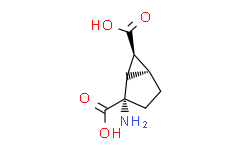| 中文名称: | Eglumegad | ||||
|---|---|---|---|---|---|
| 英文名称: | Eglumegad | ||||
| 别名: | (1S,2S,5R,6S)-2-氨基双环[3.1.0]己烷-2,6-二羧酸 LY354740; (1S,2S,5R,6S)-2-Aminobicyclo[3.1.0]hexane-2,6-dicarboxylic acid | ||||
| CAS No: | 176199-48-7 | 分子式: | C8H11NO4 | 分子量: | 185.18 |
| CAS No: | 176199-48-7 | ||||
| 分子式: | C8H11NO4 | ||||
| 分子量: | 185.18 | ||||
基本信息
|
产品编号: |
E10619 |
||||
|
产品名称: |
Eglumegad |
||||
|
CAS: |
176199-48-7 |
储存条件 |
粉末 |
-20℃ |
四年 |
|
|
|
||||
|
分子式: |
溶于液体 |
-80℃ |
6个月 |
||
|
分子量: |
185.18 |
-20℃ |
1个月 |
||
|
化学名: |
(1S,2S,5R,6S)-2-Aminobicyclo[3.1.0]hexane-2,6-dicarbo |
||||
|
Solubility (25°C): |
|||||
|
体外:
|
DMSO |
|
|||
|
Ethanol |
|
||||
|
Water |
|
||||
|
体内(现配现用): |
|
||||
|
<1mg/ml表示微溶或不溶。 |
|||||
|
普西唐提供的所有化合物浓度为内部测试所得,实际溶液度可能与公布值有所偏差,属于正常的批间细微差异现象。 |
|||||
|
请根据产品在不同溶剂中的溶解度选择合适的溶剂配制储备液;⼀旦配成溶液,请分装保存,避免反复冻融造成的产品失效。 |
|||||
制备储备液
|
浓度
溶液体积 质量 |
1mg |
5mg |
10mg |
|
1mM |
5.4002mL |
27.0008mL |
54.0015mL |
|
5mM |
1.0800mL |
5.4002mL |
10.8003mL |
|
10mM |
0.5400mL |
2.7001mL |
5.4002mL |
生物活性
|
产品描述 |
一种有效,选择性的 group II (mGlu2/3) receptor 激动剂。 |
|
|
靶点 |
mGluR2R 5nM (IC50) |
mGluR3R 24nM (IC50) |
|
体外研究 |
Eglumegad (LY354740) down-regulates spots 1014,1822 (hypoxia up-regulated protein 1),4513 (an isoform of protein disulfide isomerase 3),6204,6312,7306 (26S proteasome non-ATPase regulatory subunit 7) and protein spots 1013 and 6005 (destrin),and up-regulates spot 6507 (collapsin response mediator protein 1) in mouse cortical neurons. |
|
|
体内研究 |
Eglumegad (LY354740) (15 or 30mg/kg,i.p.) has no effect on spatial working memory performance in Gria1−/−or WT mice,and it has no effect on rewarded alternation testing with a short inter-trial interval in Gria1−/−and WT mice at concentration of 30mg/kg.Eglumegad (LY354740) (15 or 30mg/kg,i.p.) reduces spontaneous locomotor activity in wild-type and Gria1−/−mice.Eglumegad (LY354740) (15mg/kg,i.p.) dreases novelty-induced hyperlocomotion in naive GluA1-KO and prehandled GluA1-KO males,but not in females.Eglumegad (LY354740) (15mg/kg,i.p.) significantly reduces the increased c-Fos expression of GluA1-KO males to the level of WT males,but not in of females.Eglumegad (LY354740) (10mg/kg,i.p.) attenuates the immobilization stress-induced increase in BDNF mRNA expression in the rat mPFC. |
|
推荐实验方法(仅供参考)
|
动物实验: |
|
|
Mice In Experiment 1A wild-type (female:N=6;male:N=5) and Gria1−/−mice (female:N=7;male:N=8) first receive 30 trials of drugfree testing (five trials per day for 6 days). Each animal is then tested on rewarded alternation following an injection of either Eglumegad (LY354740) (15mg/kg) or vehicle.After injection animals are returned to the home cage for 30 min before behavioural testing commenced. Each animal is given 10 trials of rewarded alternation in the T-maze.Mice are given a maximum of 120 s to a complete a trial.At least 24h after the first round of drug testing the animals are re-tested in the absence of any drug treatment to ensure that there are no long-term effects of the drug,and that the mice maintain a high level of alternation performance.Twenty-four hours after this re-testing, mice receive a further 10 trials of rewarded alternation testing,but now under the drug condition that they have not previously received.The order of drug exposure is counterbalanced within genotype and sex as far as possible given the numbers of mice.In all stages,the number of trials in which the animal alternated,as well as time taken to run from the start arm to the food well on the sample run (sample latency),and the time taken to run from the start arm to making a choice on the choice run (choice latency),are recorded.Latencies are measured by the experimenter using a stopwatch.The experimenter is blind to the genotype and drug allocations of the animals throughout testing.In Experiment 1B,separate groups of male wild-type (N=7) and Gria1−/−mice (N=7) undgo the same procedure as Experiment 1A but now they receive either vehicle or a higher dose of Eglumegad (LY354740) (30mg/kg).Subsequently,in Experiment 1C,to investigate the potential effects of increased proactive interference,the procedure used in Experiment 1B is repeated in the same mice,using the same drug dose (30mg/kg),but now using a modified testing protocol in which the interval between trials is reduced to 20s. Rats Two experiments are conducted.The first experiment compares the effects of LY354740 (10mg/kg,i.p.,neutralized to a pH~7.4) or vehicle (0.9% saline neutralized to pH~7.4) in rats remaining in their home cages or rats exposed to 2h of immobilization stress in plastic cones (n=7,cage control/vehicle;n=7,cage control/LY354740;n=6,stress/vehicle;n=6,stress/Eglumegad (LY354740)).The second experiment compares two lower LY354740 doses (1 and 3mg/kg,i.p.) or vehicle in rats exposed to a 2-h period of immobilization stress to rats treated with vehicle in their home cages (n=4 for all groups).All animals are injected with either Eglumegad (LY354740) or vehicle 15 min prior to being placed in plastic cones with the open end securely closed.All immobilized rats are placed in plexiglass chamber with animal bedding on the bottom;brought to a quiet room outside of the animal colony;and immediately placed in a plastic cone.Two hours after being placed in the plastic containers,the rats are decapitated.The brains are removed and frozen on dry ice,and stored at −80℃. |
|
本计算器可帮助您计算出特定溶液中溶质的质量、溶液浓度和体积之间的关系,公式为:
质量 (g) = 浓度 (mol/L) x 体积 (L) x 分子量 (g/mol)
摩尔浓度计算公式
用本工具协助配置特定浓度的溶液,使用的计算公式为:
开始浓度 x 开始体积 = 最终浓度 x 最终体积
稀释公式
稀释公式一般简略地表示为:C1V1 = C2V2 ( 输入 输出 )








